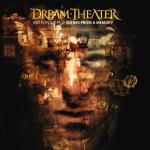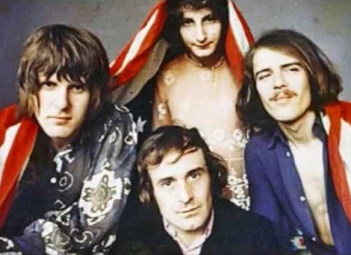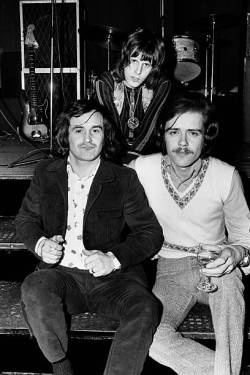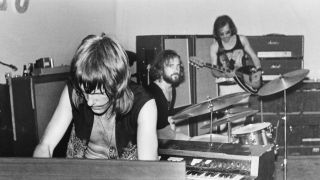The Nice – Ars Longa Vita Brevis
Progressive rock, or prog – how to discuss it? It’s a sub-genre most folks seem to have their minds made up about one way or the other. Preconceived notions such as “It’s music only musicians like,” or “It’s music only dudes like,” are common. There’s probably a lot of truth in that, but why? Women enjoy rock, jazz, and classical, so why not prog? Granted, as one who was not introduced to this music at an early age, I’ve had to dive in head-first with a few albums on which I had no idea what I was listening to. But it’s paying off. I’ve even reached a point where I’m exploring more current prog (i.e., from the last 20 years), some of which, as I’ve discovered, my wife has owned and liked all along. Funny how that works. Back to the topic at hand…


The Nice formed in the UK in 1967 and soon released their first LP, The Thoughts of Emerlist Davjack. Their style, as was that of prog in general, was an outgrowth of the psychedelic genre with more classical and jazz elements. On the heels of a couple of followup singles, including their controversial take on Leonard Bernstein’s America which Emerson described as an “instrumental protest song,” they released their second album, Ars Longa Vita Brevis, 50 years ago this month. The title is an aphorism of Hippocrates’ which translates as “Art is long, life is short.”
The band entered into these sessions as a quartet consisting keyboard madman Keith Emerson, bassist Lee Jackson (who also handled most of the vocals), Brian Davison on drums, and guitarist David O’List. Tension between O’List and the rest of the band led to his dismissal or to his quitting during the sessions, depending upon who is asked. O’List would go on to join the first incarnation of Roxy Music. Steve Howe was auditioned to replace him, but when he declined their offer to join, they decided to move forward as a trio.

On this album, which AllMusic’s Bruce Eder considers groundbreaking, we hear and glimpse what Keith Emerson would become famous for: his flair for the dramatic. The music itself was dramatic, as was the way Emerson would sometimes violently play his Hammond organ. On this disc, there’s a little something for every prog fan, with classically themed shorter songs on the first side, and the Ars Longa Vita Brevis suite on the flip side.
The record has an exuberant beginning on Daddy Where Did I Come From?, which is dominated by Keith’s keyboards and a Davison’s drums. It’s heavy psych-rock that rolls into the jazzy second song, Little Arabella, which is almost on the cheesy side but which works in the context of the album. The band lets loose on the next track, Happy Freuds. As Dave Swanson notes on ultimateclassicrock.com, Syd Barrett’s influence is quite evident here, and that the following song, the band’s take on Sibelius’ Karelia Suite (1893), was the seed of what would ultimately be Emerson, Lake & Palmer’s calling card.

Side two is, to me, an over the top affair consisting of the nearly 20 minute Ars Longa Vita Brevis, complete with a prelude, four movements, and coda. Perhaps it’s simply the drum solo which squelches my interest. I do find the “3rd Movement,” Acceptance (Brandenburger), and “4th Movement,” Denial, to be rather enjoyable.

Ars Longa Vita Brevis, and prog in general, is not everyone’s cup of tea. The core of what is liked and disliked about the genre can be found on this album: It’s teeming with Emerson’s virtuosity and creativity on keyboards in a manner not heard before. It can also be heard as bloated and pretentious, which, to me, isn’t always a bad thing. With this album, and later with ELP, I find the shorter songs to be more interesting as they were able to pack a lot into four minutes. It’s not that I don’t like any longer works, but they tend to be the ones by King Crimson and Yes. Either way, along with early Pink Floyd, this is what I imagine underground London sounded like. If you aren’t familiar with it, give it a listen and let me know what you think.
Tracklist:
Side One:
- Daddy, Where Did I Come From?
- Little Arabella
- Happy Freuds
- Intermezzo from the Karelia Suite
- Don Edito el Gruva
Side Two:
- Ars Longa Vita Brevis
- Prelude
- 1st Movement: Awakening
- 2nd Movement: Realisation
- 3rd Movement: Acceptance “Brandenburger”
- 4th Movement: Denial
- Coda: Extension to the Big Note
Here is the aforementioned second single for the Nice, America. When they played it at the Royal Albert Hall, Emerson set an American flag on fire, earning the band a permanent ban from the venue.
-Stephen
https://en.wikipedia.org/wiki/Ars_Longa_Vita_Brevis_(album)
https://en.wikipedia.org/wiki/The_Nice
http://ultimateclassicrock.com/the-nice-ars-longa-vita-brevis/
https://www.allmusic.com/album/ars-longa-vita-brevis-mw0000198046
I revisit this music often. ELP brought me to them. Love their take on ‘She Belongs To Me’ A fave Bob cover.
LikeLike